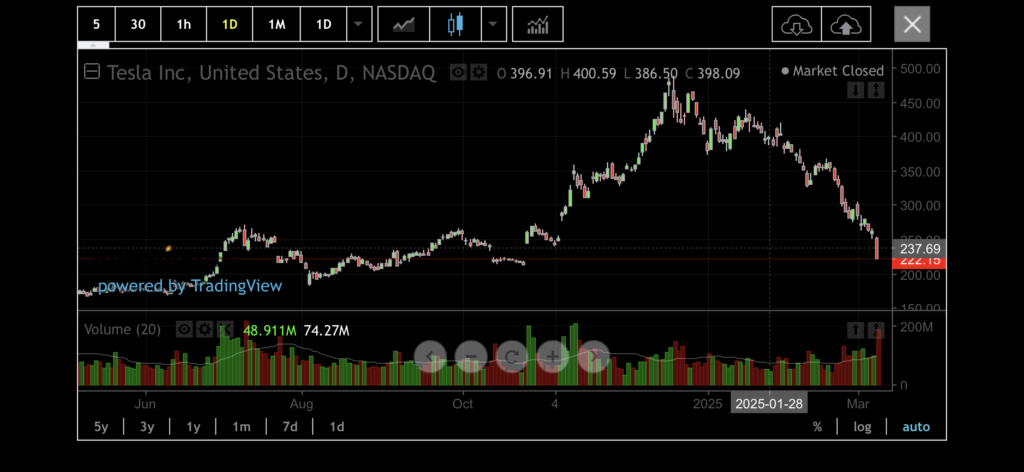
On March 10, 2025, Tesla’s stock price dropped to $212, a significant decline from its previous highs. This dip coincided with Elon Musk’s statement that this is the “most difficult period” to run Tesla, sparking debate among investors. Is this a moment of opportunity to buy the stock at a discount, or a signal of deeper troubles ahead? Let’s explore the situation, think about Tesla from different angles, and predict what might happen over the next 1-2 years.
What’s Happening Now?
Tesla’s stock has been on a rollercoaster, and hitting $212 reflects a mix of challenges. Musk’s comment about the tough times suggests the company is grappling with serious hurdles. Here are some key factors likely at play:
- Rising Competition: Tesla isn’t alone in the electric vehicle (EV) game anymore. Companies like BYD (which has surpassed Tesla in global EV sales) and traditional automakers are flooding the market with competitive options, challenging Tesla’s dominance.
- Sales Slumps: Reports show Tesla’s sales dropping sharply in key regions like Europe. For instance, in Germany, sales fell nearly 60% year-over-year in January 2025, even as overall EV demand grew. Similar declines have hit Australia and other markets.
- Price Cuts and Margins: To stay competitive, Tesla has slashed prices on models like the Model 3 and Model Y. While this might boost sales volume, it’s squeezing profit margins, raising concerns about profitability.
- External Pressures: Supply chain issues, regulatory changes (like potential cuts to EV subsidies in the U.S.), and Musk’s polarizing public persona could all be weighing on the company.
This paints a picture of a company under pressure, which explains the stock’s drop and Musk’s grim outlook. But Tesla’s story doesn’t end here—let’s look at it differently.
Rethinking Tesla: Beyond Just an Automaker
To decide if now’s the time to buy, it’s worth viewing Tesla through a fresh lens, not just as a car company but as something more:
- A Tech Innovator: Tesla’s investments in autonomous driving (like Full Self-Driving software and the Cybercab robotaxi) and AI (think Optimus, the humanoid robot) position it as a technology leader. If these bets pay off, they could dwarf its EV business in value.
- An Energy Powerhouse: Tesla’s energy storage and solar divisions are growing fast—recent earnings show energy revenue up over 50% year-over-year. This diversification could cushion it against EV market volatility.
- A Global Player: With factories in the U.S., China, and Germany, Tesla can adapt to regional challenges, like trade tensions, better than competitors tied to one market.
This perspective suggests Tesla’s current struggles might be a bump in a longer, more transformative journey. But is that enough to buy now?
Is It Time to Buy?
Whether $212 is a buying opportunity depends on your timeline and risk tolerance. Let’s break it down:
Short-Term View (1-2 Years)
The next couple of years look bumpy for Tesla:
- Headwinds Persist: Sales declines, tighter margins, and regulatory uncertainty could keep the stock volatile or push it lower. A potential U.S. recession might also hurt demand for pricey EVs.
- Bright Spots: Tesla plans to launch affordable models in mid-2025. If these hit the mark, they could reverse sales trends. Progress on FSD in markets like China or Europe could also lift sentiment.
- Verdict: If you’re a short-term trader, caution makes sense. The risks are high, and waiting for more stability might be smarter. But if you thrive on volatility, a dip below $212 could be a speculative buy.
Long-Term View (Beyond 2 Years)
Zoom out, and Tesla’s future looks more promising:
- Growth Drivers: Success in autonomy, energy, and new markets (like India or Southeast Asia) could fuel a rebound. The Supercharger network and brand loyalty remain big advantages.
- Musk’s Track Record: Tesla has defied skeptics before—think back to its rise as the first profitable EV maker. If Musk pulls off even half his vision, the upside could be huge.
- Verdict: For long-term investors, $212 could be a steal if you believe in Tesla’s innovation and can stomach the turbulence.
Prediction for the Next 1-2 Years
Over the next 1-2 years, Tesla’s stock will likely stay volatile, swinging between $180 and $250, depending on a few key developments:
- New Models: If the 2025 affordable EVs flop or face delays, the stock could slide closer to $180. A strong launch might push it toward $230-$250.
- Autonomy Milestones: Regulatory approval for FSD in new regions or a Cybercab debut could spark a rally. Setbacks might deepen the slump.
- Market Conditions: A global economic downturn could cap gains, while a recovery might amplify them.
- Competition: If BYD or others keep gaining ground, Tesla’s share could stagnate. Innovation (e.g., better batteries) could help it pull ahead.
By mid-2027, if Tesla stabilizes sales and delivers on autonomy or energy, the stock could climb back toward $300+. But if challenges pile up—say, a major FSD failure or prolonged sales woes—it might linger below $200.
Final Take
Tesla at $212 on March 10, 2025, with Musk calling it the toughest time to run the business, is a crossroads. Short-term risks are real: competition, sales drops, and uncertainty could drag it lower. Yet, Tesla’s tech edge, energy growth, and global reach offer long-term hope. If you’re a risk-taker with a 3-5 year horizon, buying now could pay off big. If you prefer safety, wait for signs of recovery—like stronger sales or FSD breakthroughs. Either way, Tesla remains a wild ride—buckle up and decide what you’re betting on.
What do you think—buy, hold off, or sell? Let’s hear your take!